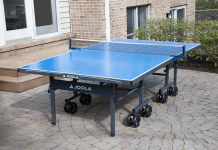While I look out my back porch window this November morning and watch the leaves change color, a board game that comes to mind that I would like to review would be that of the game Tiny Towns. From a bit of an abstract sense, when playing Tiny Towns, it comes to mind the travels that may be taken on a road trip through New England in autumn.
From more of a linear sense, Tiny Towns involves more than a little bit of strategy in the pursuit of building your communities which will of course guide you along in winning the game. Overall, Tiny Towns is one of the beams of sunshine that we can catch in between the exposure that we seem to have to so much artificial light in our world. It is always a positive when we as family and friends can bring out our board games to share experiences of bonding as well as camaraderie and Tiny Towns is certainly no exception.
Table of Contents
Overview
The number of players that can play Tiny Towns at one time range from one person to six, with the age range being stated as fourteen and up and the average play time being between forty-five minutes to an hour.
Each player of Tiny Towns is designated as the mayor of their own respective towns which are set in a forest. The towns will be inhabited by small woodland creatures that are safe from predators in this Sylvanian paradise, but I would like to add that this only serves as a backdrop to Tiny Towns and does not really affect the playing of the game itself.
The premise of Tiny Towns as a moral to the story is to promote the building of your community with wasting none of the resources as well as to create the tiny town that is the most successful. To achieve the goal of a flourishing tiny town, the following items will need to accomplish the following tasks. First, you will have to set the resource cubes in certain patterns onto your town grid (which is the card that you will be given that is similar in design to a Bingo card) to be able to build your tiny town’s buildings.
In turn, the buildings that you have will score you Victory Points, and ultimately whoever has the greatest amount of Victory Points will win.
As with most board games, Tiny Towns has its sequence of initial set up which involves steps such as sorting through the building materials which you will be using to be able to create your towns.
Once the set-up has been established, the game states to randomly pick a player that is the keeper of the master builder hammer, who will announce at each round which building materials to use. For some serious gamers, if there is question on who should be the first player to have the master builder hammer, I would suggest perhaps rolling dice from another game or drawing cards.
I mention this because some folks that take their gaming seriously may not want to decide on someone for this position at random and I would like to offer this as a possible solution. It becomes interesting as the master builder announces what type of building materials to be used and in this, quick “think on your feet” strategy must be devised.
Playing the Game
Within this process, the master builder will be declaring which resource is to be used for that round. This gets each mayor to think about where they are going to place said resource because there is a catch: Once the resources have been placed to create the town’s buildings, they must stay in that location.
It should also be noted here that although it may be tempting to put up a bunch of taverns on your town, bear in mind that the buildings will not gain you points all by themselves. As it is in real life, towns cannot operate without farms and the town is interlocked onto what it requires to achieve its prosperity.
The building materials are represented as small wooden blocks, which are painted, and color correspond on the cards with what they represent. For example, brick is represented as brick red, and wood is given a dark brown color. This contributes to the ease of playing the game and seems to assist in helping to learn the game quickly, which is one of its more endearing qualities.
In other words, it is not complicated to learn. I personally like the monument cards and pieces as they are used as the proverbial “ace in the hole” as found when playing poker. The monument card is the last card played and delivers the final say as to is the winner of that game of Tiny Towns. It should be noted that the monument card can only be played once during that game.
To elaborate on the game play of Tiny Towns, the master builder will be announcing on each round which building material will be used. For example, if they say “glass”, then glass will be used.
Something that may be interesting to note as well would be that if the master builder is telling everyone to use “glass” for example in their buildings for that round, would it be assumed that everyone’s tiny towns may be the same at one point? The answer is surprisingly they don’t. And that is one of the most engaging things about this game, everyone being able to put their own touches on their towns and enjoy doing it.
Admittedly for me personally, the moving of squares around to create and build your buildings is a bit confusing. For example, I would like to mention that once the buildings are positioned on the mayor’s respective boards, the buildings cannot be moved from those squares. With that being stated, when constructing the buildings, they can be positioned in any way on the player’s card that this town’s mayor would like to build it.
This is providing that the squares are placed into the same pattern that is found on that building’s respective card. It should also be noted that blocks cannot be put together to create interlocking buildings. This type of set up regarding the materials blocks is reminiscent for me for when I was first learning Classic Scrabble.
I had thought that I could place letters against each other when learning on my first Scrabble game. I immediately found out that this couldn’t be done unless the letters would spell a word. In this respect, the block placement for the town buildings in Tiny Town runs along similar track where they must be set a certain way. But do not despair; Tiny Towns has the Cavern Rule which helps to learn the game at a perhaps slower pace for some people.
If you run into this issue, I would suggest a “test run” or two of the game using the Cavern Rule until who you are presuming will become your regular players all get used to this. What I mean by this is to play a round or two of Tiny Towns without counting any of the points. For some gamers, this may help to keep game play on a friendly level, the way that it was meant to be.
Once all the towns have been built and the monuments have been erected, all the points are tallied and with using the cards to total the points, whichever mayor has the most points is the mayor that wins.
For me, I really do like to see how all the tiny towns turned out at the end of the game and it does help to strategize for the next time that the game is played. More experienced gamers may not find this game to be as challenging as others. With that being stated, I would like to say that when figuring out your strategy, it does get you to think quickly, even with being able to see what your opponents are building as far as their towns go.
Regarding storage, Tiny Towns is not exceptionally bigger than any other board game, at least from the perspective of letting you board games sit flat on a shelf. The colors that are found on the cards and blocks are vibrant and give the feeling of a positive energy in the pursuit of building small towns in the forest. The artwork itself found on the cards representing the buildings are the types of paintings that one would want to step into and lose themselves in as they continue the building and establishing their Tiny Town.
Wrapping Up
In conclusion, Tiny Towns has a very quaint and unique combination of several different board games that I have played in the past. I had personally warmed up to this game as it reminded me of when I had learned how to play Settlers of Catan when I was deployed to the Middle East.
The parallels between Settlers of Catan and Tiny Towns were somewhat paradoxical for me in the sense that Catan was between played in a foreign country with the game taking place in seemingly ancient and faraway land whereas learning about and playing Tiny Towns was taking place in the comfort of my own home.
In many respects, I feel that if Tiny Towns were compared to something edible, it would be comfort food such as tomato soup and grilled cheese on a cold, rainy night, which would be a great time to play Tiny Towns, come to think of it.

Veronica is a Green Bay-based freelance writer and editor with extensive experience with board games. When not busy scribbling her thoughts, you might find her in her garden, hiking out in the woods, or exploring new food joints.
Veronica is a die-hard board game and chess hobbyist by night. She likes to try out new games and is always on the lookout to recruit new players for her game night (so beware!). When not playing board games or throwing darts, she is usually busy painting miniatures (or doing other nerdy stuff).
She is the CEO & Content Writer of Indoor Games Zone. She shares her expertise from years of playing chess, board games, and darts.

![Stiga XTR Pro Review | 1,559+ Global Ratings (In-Depth Guide) [year] Stiga XTR Pro Review](https://indoorgameszone.com/wp-content/uploads/2021/08/Stiga-XTR-Pro-Review-218x150.jpg)






